Histories of libraries are important because they help to both validate the existence of libraries and authenticate their records of service over time. This is why we are so grateful to our colleague Julie Gick for writing and granting us permission to post her meticulously researched article, HISTORY OF THE NEW YORK COUNTY SUPREME COURT LIBRARIES, on this blog. It includes information about both the Civil Term and the Criminal Term libraries of the New York County Supreme Court and certainly meets the criteria mentioned above regarding the importance of library histories. We encourage you to read this very informative and entertaining article
David Badertscher.
Note: This article has been updated to include additional information provided by the author on October 27, 2008
History of the New York County Supreme Court Libraries
BY Julie Gick*
Beginnings
The New York County Supreme Court Law Library’s enabling statute was Chapter 722, Laws of 1865, effective May 12, 1865, although Griswold gives a starting date of 1852. (1)
The library was first known as the New York Law Library, and justices of the Supreme Court of the First Judicial District were its trustees.
The statute required trustees of the State Library to place in the new library any duplicate books in their possession which they deemed proper and the Clerk of the Court of Appeals was required to send one copy of the printed cases and points in all Court of Appeal cases. Any person who willfully injured any of the books, furniture or property of the new library was guilty of a misdemeanor. The sum of $5000 was appropriated for the use of the library. In 1879 the librarian’s salary was $1,500. The New York Times expressed concern about the court’s expenditures. (2)
Buildings
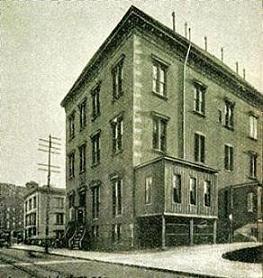
The law library was first located at 32 Chambers Street. This building is variously known as the Court of General Sessions, Marine Court and City Court. (3) The architect may have been John McComb,Jr. who designed the new City Hall and other buildings in the area.
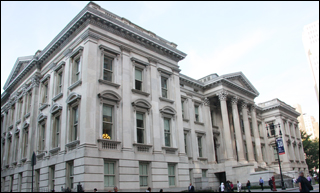
Architects John Kellum and Leipold Eidlitz designed the Tweed Courthouse, 52 Chambers Street at an estimated cost of $11-12 million. Also known as the Old New York County Courthouse, the library relocated to this new facility when it was completed in 1881. Over the years the library served as a lounge room, reference room, and sometimes as a courtroom. Although a handsome edifice the courthouse suffered from inadequate space and unsanitary conditions. The deaths of several justices and many clerks and court officers had been attributed to a malodorous and pestilential atmosphere pervading certain courtrooms. (4)

After the appellate branch was created effective January 1, 1896, the books and the Supreme Court librarian were assigned to the new court’s temporary quarters on the third floor at 111 Fifth Avenue corner of 18th Street. The Supreme Court Library was replaced by books from other courts, and an assistant librarian was hired to maintain its collection. In 1900 the Appellate Division 1st Department moved to its present quarters at 27 Madison Avenue. James B. Lord was the architect. He completed the building under budget for approximately $630,000. He died of a lingering illness said to be directly caused by a court proceeding. (5)
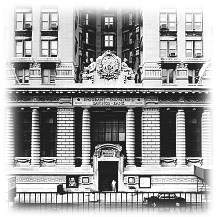
In 1907 the Emigrant Industrial Savings Bank, located at 49 Chambers Street, purchased the adjoining property at 43 – 47 Chambers Street. An architect named Raymond F. Almirall was hired to design a new building for the entire expanded lot. This was completed in 1912. At seventeen stories it was one of the tallest of the early skyscrapers in the downtown area. On March 15, 1912 the justices of the Supreme Court decided to move their offices and the library to this building. The library was located on the 12th floor. It was 25 x 100 feet and contained 5110 feet of shelving. (6)
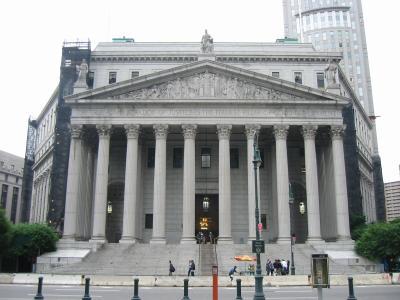
The present day New York County Courthouse, 60 Centre Street, was completed in 1927 at an estimated cost of $30,000,000. It was modified into a hexagonal structure from the original plan. The architect was Guy Lowell who in 1913 won a competition for his striking circular design. A week before the scheduled opening, Mr. Lowell died suddenly in Madeira, Spain. This is the home of the Supreme Court Civil Term Law Library. (7)
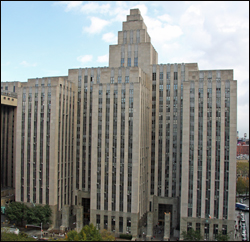
The New York County Supreme Court Criminal Term Law Library is located in the Criminal Courts Building. This edifice was completed in 1938 at a cost of $14 million, and was designed by architects Wiley Corbett and Charles B. Meyers. Until the merger in 1962 the Law Library served as the library for the Court of General Sessions which had its own impressive history. The first Presiding Judge (then called a Recorder) was James Graham who served from 1683 to 1688. At the time it was discontinued and made part of the Supreme Court in 1962, the Court of General Sessions was known as the oldest continuously functioning criminal court in the United States. (8)
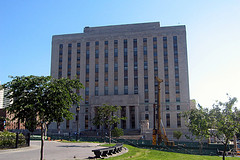
Prior to the creation of the 12th Judicial District Bronx Supreme Court Library was a part of the New York Supreme Court 1st JD. The courthouse was built in 1933 at a cost of $8 million and designed by Max Hausel and Joseph H. Freedlander. It is also known as the Mario Merola Building. (9)
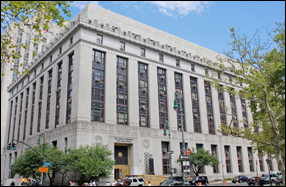
The New York County Courts Public Access Law Library opened February 14, 1995 and provides legal materials and information to the public. It is located at 80 Centre Street. The building, completed 1928-1930 at a cost $6 million was designed by William E. Haugaard, the state architect, under a height restriction so that it would not overshadow the nearby courthouses. (10)
The Staff
Through the years the law libraries have been staffed by many able professional librarians, clerks, and support personnel. This paper documents only the known head librarians.
Early Supreme
The first librarian was probably Edward J(ohn) Knight. He was for many years the librarian of the Supreme Court. Mr. Knight was born about 1829 in West Farms, New York and died June 16, 1889 of endocarditis and articular muscular rheumatism. He is buried in Cypress Hills Cemetery. During the Civil War he was a member of Company A, 71st Regiment, and was honorably discharged. (11)
Samuel Goldberg, born Boston 1841, came to New York City as a young man, and for ten years was assistant cashier of the London Globe Fire Insurance Company. Subsequently he became a member of the New York Oil Exchange. He made a lot of money, but lost it all in unsuccessful speculations. He served as private secretary to Presiding Justice Van Brunt beginning Jan. 1884, and was appointed librarian in 1886. Mr. Goldberg caught pneumonia and died ten days later on March 27, 1894. (12)
Thomas S. Hume was born about 1866 and died January 24, 1927. He was a nephew of Judge Charles H. Truax. When the Appellate Division was created effective January 1, 1896 it moved into temporary quarters on the third floor at 111 Fifth Avenue corner of 18th Street. Mr. Hume, then librarian of the New York Supreme Court, continued in the capacity of librarian of the Appellate Division, 1st Department. (13)
The new 1896 court rules created the position of Assistant Librarian of the Supreme Court, and detailed the responsibilities and duties of the librarian and assistant librarian as follows:
Appellate Division Rules for Court Attaches, Rule III
It shall be the duty of the librarian to take charge of the library of the Appellate Division of the Supreme Court, to attend in the room of such library each day during the session of the court, when the court is in session, and when not in session, from 10 o’clock in the morning until 4 o’clock in the afternoon, or as much longer as he shall be required by either of the Justices of the Appellate Division, and to perform generally such duties in relation to such library as either of the said Justices shall require. He shall be responsible for all books in the library, and shall see to it that all books removed from the library to the courtroom or elsewhere are returned to the library, and shall be responsible generally for the safekeeping and proper condition of the books and furniture in the library room.
The assistant to the librarian shall have charge of the library for the use of the Justices of the Supreme Court. He shall attend at the County Courthouse from 10 o’clock in the morning and as much longer as any Justice of the Supreme Court shall require, and he shall be responsible for the safety and condition of the books in the library and of the furniture in the library room, and for the return of all books taken to the courtrooms or elsewhere. No books pertaining to that library shall, under any circumstances, be removed from the County Courthouse, and the assistant librarian shall enforce all orders in regard to the safekeeping and preservation of such books as shall be made from time to time by a Justice of the Supreme Court. (14)
Supreme Trial Court
William G (eorge) Scott, presumed to be a brother of Hon. Francis Markoe Scott, was appointed Assistant Librarian in charge of the Supreme Court effective January 1, 1896, at an annual salary of $2500. Mr Scott was born about 1852 and, according to the U.S. 1900 census, was retired. (15)
William Fargo Kip was born April 8, 1855 in East Aurora, NY and died July 6, 1905 of paralysis in Provincetown, MA. He is buried in Buffalo, NY. Mr. Kip received his BA from Harvard in 1876, LLB from Columbia in 1879, and was admitted to the Bar in 1898. He was appointed Assistant Librarian at $2000 from the civil service eligible list by AD 1st Dept., on November 10, 1896. He became librarian of the Bar Association on April 1, 1898. (16)
Harry E. (H. E.) Griswold served as Assistant Librarian, Supreme Court, for nearly thirty years, beginning in 1898. He was the son of Stephen B. Griswold who was for 37 years head of the State Law Library and was known as the “Father of the Law Library.” Harry Griswold was born about 1863 and died March 11, 1934, in Yonkers, NY. He is buried in the Albany Rural Cemetery. Like his father, Mr. Griswold worked in the State Law Library, and was for 18 years Assistant Librarian. The Albany Law Journal wrote: “Our acquaintance with Mr. Griswold and his work at the State Library enables us to say that the judges have made no mistake in the appointment…. He had acquired in a remarkable degree the rare faculty of …knowing where to find the law.” Mr. Griswold prepared several compilations of statutes and law catalogues. (17)
Edward J. McCullen was born May 28, 1886. He attended evening classes at Fordham and New York University, and was admitted to the 1st Dept. in 1931. He served as librarian of the Supreme Court in New York county from1926 until 1942. In 1933, at the request of the Library Committee, Mr. McCullen drafted legislation to effect consolidation of the Library for the County Officials in the Bronx with the New York County Supreme Court Library. This was enacted as Chapter 691, Laws of 1933 (Education Law section 1166). When he was elected to the Court of General Sessions in 1942, Judge McCullen left his position as head of the Bronx and New York Supreme Court libraries. He retired from the bench in 1956, and died Aug. 5, 1971 in Greenwich, CT. (18)
Following Judge McCullen was Cyril Daniel McGuire. He was born Mar. 13, 1892 and died May 1983 in Budd Lake, NJ. He served as law librarian from 1943 to 1962. Mr. McGuire was admitted to the Bar 1st Dept. in 1930. (19)
From 1962 to 1973 Charles W. Flood was the librarian of the New York Supreme Court. He was born Nov. 30, 1901 and died Sept. 8, 1995 in Amityville, NY. Mr. Flood was admitted to the Bar 1st Dept. in 1934. He had charge of 60 Centre Street, 100 Centre Street and Bronx law libraries. (20)
Mr. Flood’s successor was John M. (Jack) Boyle. Mr. Boyle was born Jan. 6, 1918. He died Aug. 28, 2000 in White Plains, NY, and is buried in Calvary Cemetery. A veteran of WWII, Mr. Boyle began his career in the court system as a court officer, then library attendant, library clerk, assistant librarian, and finally, from 1973 to 1985, librarian. He was a graduate of NY Law School, admitted 1954, 1st Dept. (21)
Abraham (Abe) Montekio was born July 1, 1948. While recouperating from heart surgery, he died at Columbia Presbyterian Hospital on Mar. 20, 1987. Mr. Montekio was Principal Law Librarian of New York County Supreme Court Civil Branch Law Library from Oct. 28, 1985 until his death. He received a B.A. from LIU in 1971, MA in History, Brooklyn College, 1978, and MSLS Pratt Institute,1979. He was employed as a Law Librarian, Supreme Court Library, Brooklyn, 1978-81, Assistant Librarian, Proskauer, Rose, Goetz & Mendelsohn, 1981-83, and Librarian, Court of International Trade, 1983 – 1985. (22)
Court of General Sessions (Supreme Court Criminal Term)
It is difficult to determine the early history of libraries and librarians at the Court of General Sessions because many of the documents of the period refer to what are now non-judicial staff as “court attendants and stenographers” without making any further differentiation. There are some indications, however, of either librarian or “librarian like” activity during this earlier period. An undated report from a librarian to the Library Committee of the Judges of the Court of General Sessions includes the following:
“I have made an inspection of the Minute Books of this court and found that
they commence from 1683. They are now stored in an enclosed fire-proof
cabinet.These ncient documents have a great deal of historical value.
They are possibly the oldest records of criminal and civil procedure in this city….”
Looking through earlier records of the Supreme Court Criminal Term Library dating back to the Court of General Sessions period, there are various records of old minute books,
handwritten predecessor records of what we would now call a library catalog, etc.
Until the 1980s there was a minute book at the circulation desk of the library which contained the last entry prior to the colonies becoming independent and, on an adjacent page, the first entry after independence. During the 1980s this material was removed from the library and taken to the First Department of the Supreme Court Appellate Division.
Unfortunately, as far as can be determined, none of this material is associated with the name of a particular librarian. It appears that the first librarian who lent his name to this type of activity at the Court of General Sessions, 100 Centre Street, was Angelo Alfred Devito who became librarian in 1938. He served in the Navy during WWI, and was for 16 years librarian in New York County District Attorney’s office before transferring to the Court of General Sessions. He worked there for six years, and died in Bellevue Hospital, July 31, 1943, aged 50. (23)
At the time of the merger into Supreme Court in 1962, James A. Murphy was in charge of what was known as the Indictment Library. Mr. Murphy graduated Fordham Law School and was admitted to the Bar, 1st Dept. in 1942. His title was Librarian of General Sessions and Principal Consultation and Opinion Clerk. (24)
Mr. Murphy was succeeded by Thomas M. Farley, Assistant Law Librarian from 1970 – 1975. Mr. Farley was born February 16, 1924 and died April 1976. He was admitted to the Bar, 1st Dept. in 1955. (25)
Born March 27, 1928, Edgar L. Ross received AA in Psychology, Los Angeles City College, 1954; LLB, NY Law School, 1957. He died March 9, 1996. In 1976 Mr. Ross was reclassed from clerk to librarian at 100 Centre Street. He was later charged with dereliction of duties. This case ultimately went to the U.S. Supreme Court (Ross v Milonas, 454 U.S. 847, cert. den.) (26)
Bronx
Bronx Supreme Court Library had a number of Assistant Law Librarians one of whom was Ernest K. (Ernie) Jones. When the 12th JD was created in 1981 Mr. Jones became Principal Law Librarian of the Bronx Supreme Court. He was born May 22, 1922, graduated Brooklyn Law School, admitted to the Bar, 1st JD in 1951. Mr. Jones died August 12, 2002 and is buried in Kensico Cemetery. (27)
New York County Courts Public Access Law Library
The first librarian of the New York County Courts Public Access Law Library was Douglas B. Stephens. He received his BA from North Carolina Central University, 1969, and MLS from Pratt, 1973. Prior to joining the Unified Court System in 1985, Mr. Stephens had worked for Brooklyn Public Library, served as Director, Bellevue Hospital Patients Library, and as Adjunct Law Reference Librarian, Hofstra University. He was Senior Law Librarian at the Public Access Law Library for about seven years. (28)
The Collection
According to Stephen B. Griswold, by 1875 the Supreme Court Library had a collection of 2,000 books. The New York Court of Appeals Library, established in 1849, consisted of 9,000 volumes. Although a volume of Court of Appeals Reports could be purchased for $1.10, Mr. Griswold writes that …”a fairly complete law library would embrace more than 7,000 volumes which could not be placed upon its shelves for less than $50,000.” (29)
When Chapter 649 was enacted on April 30, 1898 the library known as the New York Law Library became the law library of the Appellate Division, and the law libraries of the Superior Court of the City of New York and of the Court of Common Pleas of the city and county were consolidated, and the books therein constituted the law library of the Supreme Court in the first JD. The collection was further enhanced when in 1962 the Court of General Sessions, located at 100 Centre Street, merged into the Supreme Court.
In 1933 Edward J. McCullen, then librarian of the New York Supreme Court drafted legislation which added a new Education Law section 1166 effecting consolidation of the Library for the County Officials of the County of the Bronx with the Library of the New York Supreme Court. This was substantively enacted as Chapter 691, Laws of 1933. Judiciary Law section 817 (Chapter 665, L 1946) provided for a Supreme Court library 1st JD with branches in New York and Bronx Counties. It was in the care, custody and control of the justices of the Supreme Court in the first judicial district who were not Appellate Division justices. This law was amended in 1981 by Chapter 1006 which created the 12th JD and transferred the supervision of the Bronx Supreme Court Library to the justices of the Supreme Court of the 12th JD.
Administrative Changes
When the Appellate Division, 1st Department was established in 1896 the librarian of the New York Supreme Court Library was also the assistant librarian of the Appellate Division. This continued until July 28, 1911 when Chapter 832 became effective. After that the librarian of the Supreme Court reported to the justices of the Supreme Court who acted as trustees, but who were not Appellate Division justices. By 1915, the Commissioner of (New York ) City Accounts reported that both Supreme Court Appellate Librarian and Supreme Court Trial Librarian were paid an annual salary of $4,000. (30)
In 1962 there was a major court reorganization. This resulted in the addition of the Court of General Sessions Library to the New York County Supreme Court. Until about 1980 the Bronx Supreme Court Library was maintained by staff from the New York Supreme Court. It was detached from New York County when the 12th Judicial District was created. At about the same time the New York Supreme Court Library was divided into civil and criminal term libraries with separate staffs and budgets.
Another aspect of court reform was a reclassification system in 1965 and in 1980. The Judicial Conference asked Arthur Charpentier, then Librarian of the Association of the Bar of the City of New York, later Dean of Harvard Law School, to conduct a survey and make recommendations. The reclassifications created some changes in staffing and job duties with the Law Department, a pool of Law Assistants (Court Attorneys), performing some aspects of legal research and the Library staff providing library services and maintaining the collections. (31)
When Chapter 662, Laws of 1993 was enacted, New York Supreme Court Library opened a library that would be accessible to everyone. The New York County Courts Public Access Law Library serves the community by maintaining a basic New York collection of statutes, treatises, and online material. The Civil Branch contributes funding for legal reference and equipment and the Criminal Branch furnishes staff.
Innovations
The New York County Supreme Court Law Libraries were early providers of Westlaw and Lexis. In the early 1980s a Principal Law Librarian was asked to develop a proposal for computer assisted legal research in the courts. Out of that early report came a recommendation that Westlaw be acquired for the trial courts and Lexis for the appellate courts. As far as can be determined, that recommendation was followed at the time. Later both Westlaw and Lexis were made accessible to all the courts.
Other innovations followed in both New York County Supreme Court Libraries. In the mid 1980s William Clapham, then the UCS Budget Director, designated the Supreme Court Criminal Term, New York County Library, as a testing site for reviewing and developing cost effective applications for automation. Out of that initiative came a library information management system called LIMS which is still being used, a review of scanning technology of the period, some research on the use of voice recognition with Westlaw, and an early library website. All of this activity was prior to the present Department of Technology. The staff had email and internet access in the 1990s.
Some functions of the libraries are automated, including acquisitions and cataloging. Special collections include New York civil practice and criminal transcripts. Lexis is available to the community at no charge. A toll free 800 line is maintained by staff at the Public Access Library.
Today the law libraries continue to support new programs and technologies, including system-wide document delivery and OPAC system. The Supreme Court Civil Term Library participates in e-filing, Commercial Division, Justice Initiatives, green programs, the Unified Court System’s Virtual Reference Library document delivery service and provides legal reference materials and budgetary support for our Public Access Library. The Supreme Court Criminal Term Library has developed various database and web based services to address both internal and library user needs and participates in various Unified Court System programs including document delivery services and green programs. Working with our Public Access Library, it has been providing web based outreach services to the public since 2002. The objective of our libraries has always been and will remain to provide the best quality in library services in a cost-effective manner..
______________________________________________________________________________ Notes:
* I would like to express my appreciation to David Badertscher and Theodore Pollack for their contributions to this history.
Photographs:
32 Chambers Street http://www.bycalan.com
52 Chambers Street http://www.bycalan.com
27 Madison Avenue http://www.nycourts.gov/courts/ad1/index.shtml
43 Chambers Street http://www.nyc-architecture.com/SOH/SOH027.htm
60 Centre Street http://www.freebase.com/view/wikipedia/images/commons_id/1518133
100 Centre Street http://www.nyc.gov/html/dcas/html/resources/man_criminalcourt.shtml
Bronx Supreme Court
http://wiki.worldflicks.org/bronx_supreme_courthouse.html
80 Centre Street
http://www.nyc.gov/html/dcas/html/resources/man_louislefkowitz.shtml
References to the New York Times are to the online database at http://www.nytimes.com
References to Green Book are to Green Book: Official Directory of the City of New York, various years
(1) Stephen B. Griswold, Law Libraries, Public Libraries in the United States of America: their history, condition, and management. Special report, Department of the Interior, U. S. Bureau of Education. Part I (1876) pp. 161-170, Wisconsin Digital Collections at http://digital.library.wisc.edu/1711.dl/History.PublicLibs
(2) The Municipal Civil List: Useless Offices and Large Salaries, NY Times, Feb. 17, 1879
(3) New York City Directory, 1869 (Knight Edward J. librarian, 32 Chambers, h 76 Cana.)
http://www.bycalan.com
(4) DCAS Managed Public Buildings at http://www.nyc.gov/html/dcas/html/resources/man_tweed.shtml
Court House A “Pest Hole,” NY Times, May 9, 1900 More Justices Must Sit In Packed Court House, NY Times, May 27, 1906
All Justices Condemn County Court Building, NY Times, December 14, 1906
(5) Laws of 1898, chapter 649 New Courthouse Opened: Private View of the Home of the Appellate Division, NY Times, Dec. 21, 1899 Manhattan Appellate Courthouse at http://nyc.gov/html/dcas/html/resources/man_appellatecourt.shtml
Death of James B. Lord, NY Times, June 2, 1902
(6) Justices Decide On New Chambers, NY Times, March 16, 1912 In the Real Estate Field, NY Times, October 15, 1907
(7) Guy Lowell Dies; Noted Architect, NY Times, February 5, 1927 Although the circumstances of his death were not disclosed, this writer was told by various court employees that he committed suicide.
One of the more photographed courthouses. The law library is shown in scenes from Law and Order, Tabloid, orig. air date May 13, 1998; Vendetta, orig. air date April 21, 2004; and PBS Frontline: Secret History of the Credit Card, orig. air date November 23, 2004
(8) DCAS Managed Public Buildings at http://www.nyc.gov/html/dcas/html/resources/man_criminalcourt.shtml
(9) DCAS Managed Public Buildings at http://www.nyc.gov/html/dcas/html/resources/bronx_countycourt.shtml
(10) DCAS Managed Public Buildings at http://www.nyc.gov/html/dcas/html/resources/man_louislefkowitz.shtml
In October 1998 a Scottish Television film crew made a documentary showing a relative of a Lockerbie bombing victim using the public access library for research
(11) Funeral of Edward J. Knight, NY Times, June 20, 1889 Trow’s New York City Directory, for the year ending May 1, 1865 Goulding’s New York City Directory, 1877 Civil War Widows Pension Claim, No. 451,702
(12) The Obituary Record: Samuel Goldberg, NY Times, March 28, 1894
(13) New Rules for Courts, NY Times, November 30, 1895 Hume-Gray, NY Times, April 11, 1894
Other AD 1st Dept. Librarians from Green Book include:
James Aloysius Clynes, to1942 Henry Pollmann, 1942 – 1973 Stephen R. Grotsky, 1973 –
Mr. Grotsky was succeeded by the current Principal Law Librarian, Eugene A. Preudhomme.
(14) New Rules for Courts, NY Times, November 30, 1895
1900 U.S. Census, Manhattan, Roll T623_1114, p.9B, ED 748
1880 U.S. Census, Manhattan, T9_0881, p.430C
(15) New Rules for Courts, NY Times, November 30, 1895
(16) Post In the New York Law Library, NY Times, Nov. 10, 1896
Bar Association Librarian, NY Times, Mar. 31, 1898
(17) Harry E. Griswold, NY Times, March 13, 1934 Current Topics, LVII Albany Law Journal 324 [May 21, 1898] at: http://books.google.com/book
(18) Obituary: Edward J. McCullen, New York Law Journal, Aug. 9, 1971, p.4, col.7.
(19) Green Book; Reclassification Folder
(20) Id.
(21) Death Notice: Boyle, John M., NY Times, August 31, 2000
(22) AALL Biographical Directory, 1984, p.102 Mr. Montekio was succeeded by the current Principal Law Librarian, this writer.
(23) A. Alfred Devito, NY Times, August 1, 1943
(24) Green Book; Reclassification Folder
(25) Id.
(26) Id.
Mr. Ross was succeeded by the current Principal Law Librarian, David G. Badertscher.
(27) Death Notice: Jones, Ernest K., NY Times, August 18, 2002
Other Bronx Supreme Court Librarians from the Green Book include:
Ellen Robinson, 1992-93 Diana Sheffield, 1996-97 Modesto Bravo, 2000-04 Mr. Bravo was succeeded by the current Principal Law Librarian, Margaret Beirne.
(28) Douglas B. Stephens resume.
Mr. Stephens was succeeded by the current Senior Law Librarian, Theodore Pollack.
(29) Griswold, supra.
(30) Government of the City of New York, Office of the Commissioners of Accounts New York City and New York Bureau of Municipal Research, at 1187 [Little & Ives, 1915]
31) Marc Bloustein, A Short History of the New York State Court System, The Historical Society of the Courts of the State of New York, http://www.nycourts.gov/history/
Letter from John M. Boyle to Hon. David Ross, Feb. 14, 1974, Reclassification Folder Evaluation and Allocation Appeal of John M. Boyle to Hon. Herbert B. Evans, Nov. 10, 1980, Reclassification Folder
10/27/2009
 Criminal Law Library Blog
Criminal Law Library Blog

